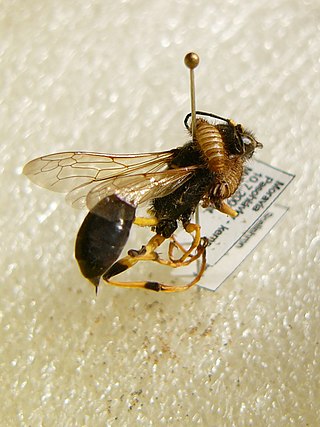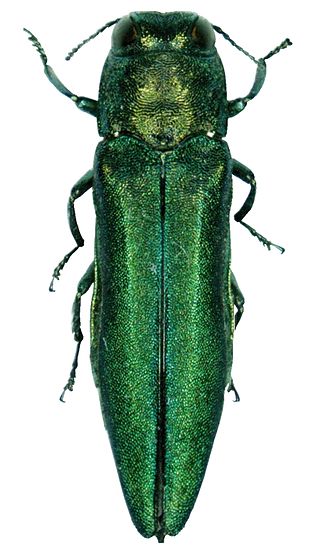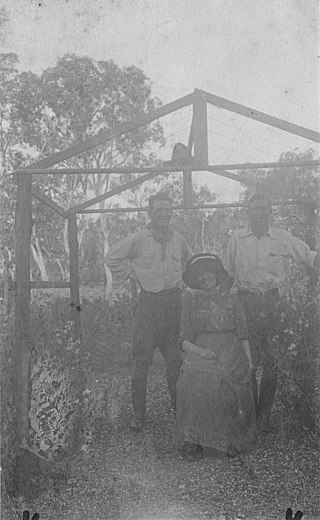
Fraxinus americana, the white ash or American ash, is a fast-growing species of ash tree native to eastern and central North America.

Biological control or biocontrol is a method of controlling pests, whether pest animals such as insects and mites, weeds, or pathogens affecting animals or plants by using other organisms. It relies on predation, parasitism, herbivory, or other natural mechanisms, but typically also involves an active human management role. It can be an important component of integrated pest management (IPM) programs.

A pest is any organism harmful to humans or human concerns. The term is particularly used for creatures that damage crops, livestock, and forestry or cause a nuisance to people, especially in their homes. Humans have modified the environment for their own purposes and are intolerant of other creatures occupying the same space when their activities impact adversely on human objectives. Thus, an elephant is unobjectionable in its natural habitat but a pest when it tramples crops.

Whiteflies are Hemipterans that typically feed on the undersides of plant leaves. They comprise the family Aleyrodidae, the only family in the superfamily Aleyrodoidea. More than 1550 species have been described.

Invasive species in Australia are a serious threat to the native biodiversity, and an ongoing cost to Australian agriculture. Numerous species arrived with European maritime exploration and colonisation of Australia and steadily since then. There is much ongoing debate about the potential benefits and detriments of introduced species; some experts believe that certain species, particularly megafauna such as deer, equids, bovids, and camels, may be more beneficial to Australia's ecosystems than they are detrimental, acting as replacements for extinct Australian megafauna.

The emerald ash borer, also known by the acronym EAB, is a green buprestid or jewel beetle native to north-eastern Asia that feeds on ash species. Females lay eggs in bark crevices on ash trees, and larvae feed underneath the bark of ash trees to emerge as adults in one to two years. In its native range, it is typically found at low densities and does not cause significant damage to trees native to the area. Outside its native range, it is an invasive species and is highly destructive to ash trees native to Europe and North America. Before it was found in North America, very little was known about the emerald ash borer in its native range; this has resulted in much of the research on its biology being focused in North America. Local governments in North America are attempting to control it by monitoring its spread, diversifying tree species, and through the use of insecticides and biological control.

Fraxinus pennsylvanica, the green ash or red ash, is a species of ash native to eastern and central North America, from Nova Scotia west to southeastern Alberta and eastern Colorado, south to northern Florida, and southwest to Oklahoma and eastern Texas. It has spread and become naturalized in much of the western United States and also in Europe from Spain to Russia.

The silverleaf whitefly is one of several species of whitefly that are currently important agricultural pests. A review in 2011 concluded that the silverleaf whitefly is actually a species complex containing at least 40 morphologically indistinguishable species.

Adelges tsugae, the hemlock woolly adelgid or HWA, is an insect of the order Hemiptera native to East Asia. It feeds by sucking sap from hemlock and spruce trees. In its native range, HWA is not a serious pest because populations are managed by natural predators and parasitoids and by host resistance. In eastern North America it is a destructive pest that threatens the eastern hemlock and the Carolina hemlock. HWA is also found in western North America, where it has likely been present for thousands of years. In western North America, it primarily attacks western hemlock Tsuga heterophylla and has only caused minor damage due to natural predators and host resistance. Accidentally introduced to North America from Japan, HWA was first found in the eastern United States near Richmond, Virginia, in 1951. The pest is now found from northern Georgia to coastal Maine and southwestern Nova Scotia as well as areas of western Michigan near the eastern Lake Michigan shoreline. As of 2015, HWA has affected 90% of the geographic range of eastern hemlock in North America.

Rose Ethel Janet White-Haney, known as Jean White-Haney, was a botanist in Queensland, Australia. She was officer-in-charge of the Queensland Board of Advice on Prickly Pear Destruction and helped develop biological control methods for managing the invasive cactus.

Neoseiulus cucumeris, the cucumeris mite, is a species of predatory mite in the family Phytoseiidae. It is used in biological pest control of western flower thrips in cucumber and some other greenhouse crops.

Encarsia is a large genus of minute parasitic wasps of the family Aphelinidae. The genus is very diverse with currently about 400 described species and worldwide distribution. The number of existing species is expected to be several times higher because many species are still undescribed. Encarsia is a very complex genus, with specimens showing both inter- and intra-specific variations, making morphological classification difficult.
Encarsia inaron is a parasitoid wasp used in the control of ash whitefly, Siphoninus phillyreae. The ash whitefly is an insect from Europe that feeds on the sap of plants, and which has become a pest in North America. E. inaron was acquired from Italy and Israel and brought to California in 1989.
Dicyphus hesperus is a species of true bug in the family Miridae. It is a generalist predator of other insects and also feeds on plant tissues. It is native to North America and has been used there in biological control of agricultural pests, especially whitefly on tomatoes.

Anthocoris nemoralis is a true bug in the family Anthocoridae. The species is native to Europe and is introduced in North America. It is a predator of aphids, spider mites and jumping plant lice, and is therefore used as a biological pest control agent.
Typhlodromips swirskii, the Swirski mite, is a species of predatory mite in the family Phytoseiidae. It is used in biological pest control of western flower thrips in greenhouse or indoor grown crops.
Hoplocampa testudinea, the apple sawfly or European apple sawfly, is a species of sawfly in the family Tenthredinidae. It is native to Europe but has been accidentally introduced into North America where it became invasive. The larvae feed inside the developing fruits of the apple tree.

Aleurocanthus spiniferus, the citrus spiny whitefly, is an insect native to Asia. It is considered an invasive pest, notably affecting citrus and tea plants. They are part of the whitefly family.
Lathrolestes luteolator is a species of wasp in the family Ichneumonidae. It is native to North America and is a parasitoid of various species of sawfly larvae. In the 1990s, it started to parasitise the larvae of the invasive amber-marked birch leaf miner in Alberta. When this pest spread to Alaska, the wasp was used in biological pest control.

Orchamoplatus citri, commonly known as the Australian citrus whitefly, is a whitefly species in the genus Orchamoplatus. It is found across Australia and New Zealand, primarily foraging on the leaves of citrus trees.















